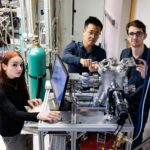Top Tech News Today, November 10, 2025

Top 10 Tech News Stories Today — Your Quick Briefing on the Latest Technology News, Global Innovation, and AI-Driven Shifts Reshaping the Future
It’s Monday, November 10, 2025, and we’re back with your quick digest of the Top 10 Tech News Stories from the past 12 hours. From Apple’s secret billion-dollar AI deal with Google and OpenAI’s push into healthcare to the rise of orbital data centers and Norway’s green-hydrogen breakthrough, today’s tech landscape spans every frontier — earthbound and beyond.
Whether you’re a founder, investor, or tech enthusiast, this daily briefing keeps you ahead of the curve — no endless scrolling, just the news that matters.
Here’s your roundup of the latest tech news making waves across the global tech scene.
Latest Tech News Today
1. Eyes Turn to Space for Power-Hungry Data Centers
Tech companies are setting their sights skyward as AI-driven energy demands soar. The idea of building data centers in space is gaining traction, offering constant solar power and efficient cooling, free from Earth’s constraints. U.S. startup Starcloud just launched a refrigerator-sized Nvidia GPU satellite via SpaceX, marking the first orbital data center test.
Meanwhile, Google’s Suncatcher project plans to test satellites by 2027, and Elon Musk says SpaceX could begin orbital deployments as soon as next year. Experts believe space-based computing could reach commercial viability within a decade, powered by reusable rockets like Starship that slash launch costs by up to 30 times. Cooling in orbit, which relies on radiators and recycled water, could make these operations greener than terrestrial ones.
Why it matters: Data centers are the backbone of the AI revolution—but they’re also straining global power grids. Moving compute off-planet could ease Earth’s energy load while ushering in a new space-tech economy where orbital infrastructure becomes the next frontier for AI.
Source: SpaceDaily
2. OpenAI Explores Consumer Health Tools in New Expansion Push
OpenAI is reportedly developing a suite of consumer health tools powered by its generative models, signaling a strategic move beyond productivity and creative tasks. The plan could include a personal health assistant capable of analyzing medical data, summarizing health records, and providing personalized wellness insights—an ambitious step into a heavily regulated industry.
The company is said to be building partnerships and internal teams to explore responsible use cases without crossing into diagnostic territory, where compliance hurdles are steep. This shift would position OpenAI directly in competition with major players like Google DeepMind and Apple Health.
Why it matters: If OpenAI succeeds, AI could become a trusted layer in personal healthcare—automating knowledge retrieval, simplifying communication with doctors, and empowering users with actionable health data. It also raises tough questions about privacy, liability, and the role of AI in medical decision-making.
Source: Reuters
3. Why Apple Wants to Keep Its Billion-Dollar Deal with Google a Secret
Apple is quietly paying Google $1 billion annually to power Siri’s upcoming AI upgrade using Google’s 1.2 trillion-parameter Gemini model. Internally codenamed “AFM v10,” the integration hides Google’s involvement to preserve Apple’s image of autonomy. The Gemini model will run on Apple’s Private Cloud Compute servers to keep user data isolated, a key part of its privacy promise.
Apple reportedly sees this as a stopgap while developing its own trillion-parameter model, aiming to launch by late 2026. CEO Tim Cook has hinted that users may eventually choose between multiple AI models—including ChatGPT—within iOS.
Why it matters: This secret partnership reveals how even the world’s richest tech giant is racing to catch up in AI. It underscores the new reality: the biggest companies are increasingly interdependent in the AI arms race—where privacy, compute power, and brand control collide.
Source: Times of India (reporting on industry and court documents)
4. AI Tech Can Compress LLM Chatbot Memory by 3–4×
Researchers at Seoul National University have developed KVzip, a breakthrough method that reduces chatbot conversation memory requirements by up to four times without losing accuracy. The system eliminates redundant contextual data in large language models like Llama 3.1 and Qwen 2.5, improving speed and cost-efficiency for long-form dialogues and summarization tasks.
KVzip has already been integrated into NVIDIA’s open-source KVPress library, making it accessible for enterprise AI systems and mobile devices. The result: chatbots that remember more, respond faster, and operate at lower cost—all without accuracy loss.
Why it matters: As AI assistants become more deeply embedded in everyday life, efficiency matters as much as intelligence. KVzip’s compression breakthrough could help scale personalized, long-context AI experiences to millions of users—especially on mobile and edge devices.
Source: TechXplore
5. Taiwan’s Chip Industry Positions Itself as a National Defense Asset
At a conference in Berlin, former Taiwanese president Tsai Ing-wen declared the island’s semiconductor sector “an indispensable part of global security,” calling chips a defense asset as much as an economic one. Her remarks come amid mounting pressure from Beijing and growing Western reliance on Taiwanese fabs like TSMC.
Tsai’s framing marks a shift in tone—positioning chip manufacturing as a deterrent and diplomatic shield in an era where silicon defines strategic power.
Why it matters: Semiconductors are the lifeblood of global tech infrastructure, from AI to defense systems. By redefining chips as strategic assets, Taiwan is signaling to allies and rivals alike that protecting its fabs means protecting the global tech order.
Source: Reuters
6. Blue Origin Scrubs NASA’s ESCAPADE Mission to Mars
Blue Origin postponed the highly anticipated launch of NASA’s ESCAPADE mission to Mars after poor weather conditions closed the 88-minute window at Cape Canaveral. The mission, carried by the company’s massive New Glenn rocket, was set to deploy twin spacecraft to study Mars’s magnetic field and atmosphere.
New Glenn’s booster, designed for reusability, stands taller than SpaceX’s Falcon 9 and features a wider payload cone—showcasing Blue Origin’s ambitions to rival Musk’s dominance in commercial space. The company says the next attempt will occur later this week.
Why it matters: The delay highlights how private spaceflight is no longer experimental—it’s infrastructure. As commercial companies ferry scientific payloads to Mars, the line between private enterprise and government space exploration continues to blur.
Source: The New York Times
7. Turning a Flaw into a Superpower: Robots Learn to Move Like Living Beings
Researchers at the University of Sheffield have reimagined hysteresis—a “flaw” in mechanical systems—as a design advantage for soft robots. Their new method, called HasMorph (Hysteresis-Assisted Shape Morphing), allows robots to bend, grow, and morph into complex shapes using just two tendons.
This approach enables billions of configurations while drastically reducing motors and complexity. The applications range from medical robotics (navigating inside the human body) to search-and-rescue drones that can snake through rubble.
Why it matters: The innovation marks a turning point in robotics design philosophy—proving that limitations can become levers of creativity. By mimicking organic adaptability, engineers are bringing robots closer to living systems.
Source: TechXplore
8. Eyes on Hydrogen: Norway’s Nel ASA Wins Deal for GreenH Projects
Norwegian energy company Nel ASA has secured a major contract to supply electrolysers for GreenH’s hydrogen production sites in Kristiansund and Slagentangen. Backed by Norway’s Enova fund, the project will deliver over 20 MW of capacity to the local maritime and transport sectors. The move underscores Northern Europe’s leadership in scaling green hydrogen as an industrial power source and export commodity.
Why it matters: Hydrogen has long been “the fuel of the future.” Projects like this show it’s finally becoming the fuel of the present—bridging clean energy ambition with deployable industrial infrastructure.
Source: Reuters (via TradingView newswire)
9. Self-Driving Lab Learns to Grow Materials on Its Own
Researchers at the University of Chicago’s Pritzker School of Molecular Engineering have built a self-driving lab that uses robotics and AI to automate the growth of thin metal films—key components in electronics, optics, and quantum devices. The system runs physical vapor deposition (PVD) experiments autonomously, adjusting temperature, timing, and composition in real time. By combining robotics with machine learning, it eliminates months of manual trial and error.
Developed for under $100,000 by an undergraduate-led team, the setup handles every step: loading samples, measuring properties, and predicting optimal synthesis parameters. In testing, it produced silver films with precise optical properties in just 2.3 experimental cycles on average—a process that normally takes weeks. The researchers plan to extend the method to more complex materials for next-generation semiconductors and quantum applications.
Why it matters: The fusion of AI and robotics is redefining how scientific discovery happens. Self-driving labs like this could shorten R&D timelines from months to days, accelerating breakthroughs in materials science and electronics—while freeing human researchers to focus on creativity instead of repetition.
Source: TechXplore
10. Why Big Tech Is Pushing Back Against Europe’s AI Act
European regulators are reportedly softening parts of the AI Act after pushback from U.S. tech giants. The changes could delay enforcement and ease compliance for high-risk systems while extending timelines for registration and audits.
The move reflects the EU’s attempt to balance innovation and regulation amid growing competition from the U.S. and China.
Why it matters: How Europe writes—and rewrites—its AI laws will set precedents for the rest of the world. A softer stance may keep Big Tech engaged in Europe, but it risks watering down accountability in the rush to stay competitive.
Source: TechXplore + industry commentary
Closing
That’s a wrap on today’s top stories shaping the global tech landscape — from space-powered data centers to AI breakthroughs redefining industries.
Stay tuned for tomorrow’s edition as we track the latest developments across startups, Big Tech, policy, and innovation.
Until then, stay curious — and stay ahead.




